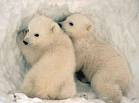Wednesday, March 17, 2010
Ethiopian Wolves & Mole Rats
Here's a little more information about the Ethiopian Wolf:
it lives in packs that share and defend an exclusive territory. This differs from most larger social carnivores that live in groups for the purpose of hunting cooperatively. In areas with little human interference, packs may average 6 adults, 1–6 yearlings, and 1–7 pups.
I hope you enjoyed this video, those Mole Rats are just adorable.
Help save these Ethiopian Wolves and Mole Rats!
Tuesday, March 16, 2010
Steller's Sea Cow

Steller's Sea Cow is an extinct mammal from the order Sirenia in the animal kingdom, which also includes the manatee and dugong. It got its name from the man who discovered it, Georg Steller. The Steller's Sea Cow was hunted to extinction in the 18th century, only 30 years after its discovery. It was killed for its meat and leather. It could way up to 11,000 kilograms. The Steller'sThe meat of the sea cow, which was most often referred to as being similar to veal, remained fresh for much longer than any other available meat source, making it extremely valuable to the Russian sailors and hunters.Although Bering's crew only killed their first sea cow six weeks before their escape in August 1742, the meat was crucial in restoring their strength during the final stages of building a new boat from the wreckage of the St. Peter. When they left, they took a supply of meat and fat, and stories of the incredible riches of the islands for fur hunters. Those hunters flocked to the area, and in 1768, explorer Martin Sauer entered in his journal an account of the death of the last known sea cow.
(Extinct since 1754)
Thursday, March 4, 2010
Endangred Animal Video
Here's a video of Endangered Species. I hope this video helps people realize that animals are a big part of nature!
Hope you enjoyed this video!
Hope you enjoyed this video!
Wednesday, March 3, 2010
The Spectacled Bear

The diminutive spectacled bear makes its home in the dense Andean jungles of South America, and it has the distinction of being the continent’s only bear.
Spectacled bears wear shaggy fur that is black, brown, or sometimes reddish. They are so named for the whitish to yellowish rings that encircle their eyes, resembling large eyeglasses. These lines, however, don't always fully encircle the eyes, and some individuals lack the markings altogether.
Spectacled bears, also called Andean bears, are among the smallest members of the family Ursidae. Males, which are significantly larger than females, grow over 5 feet (1.5 meters) in length and weigh up to 340 pounds (154 kilograms). Females rarely weigh more than 180 pounds (82 kilograms).
Intensely shy bears, they prefer the lush, isolated cloud forests on the slopes of the Andes, climbing as high as 14,000 feet (4,300 meters). They will descend to search for food though, and have been seen in widely differing habitats, from rain forests, to steppe lands, to coastal deserts.
Spectacled bears are generally nocturnal and are primarily vegetarian, harvesting fruit, berries, cacti, and honey. Highly agile climbers, they have been known to sit in a tree for days on a platform made of broken branches, waiting for fruit to ripen. They have extremely strong jaws and wide, flat molars to chew tough vegetation such as tree bark and orchid bulbs. Occasionally they will supplement their diet with meat, taking small rodents, birds, insects, and even small cows, making them the largest carnivores in South America.
Help save more of these cute creatures!
Subscribe to:
Posts (Atom)
